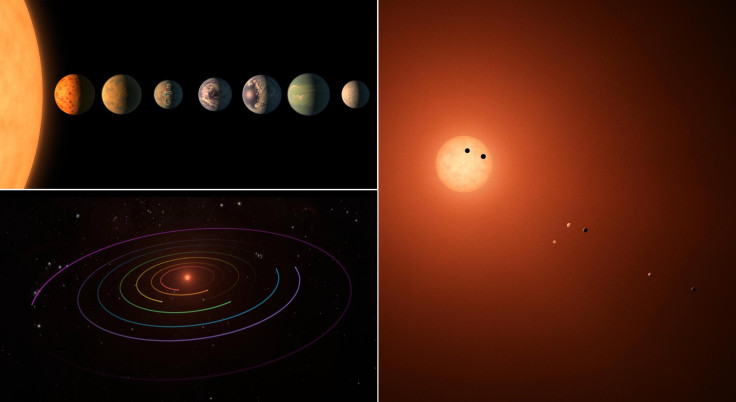How Did Alien Solar System Form? Trappist-1 Planet Pieces Melted Together At Ice-Water Zone

When astronomers first found the Trappist-1 solar system, part of what made the discovery of the seven Earth-sized exoplanets so novel was how unusual it was to find that many planets orbiting their small star so closely, about a tenth of the distance between the Earth and the sun. But scientists may have solved the riddle, attributing the planets’ compact formation to the unique conditions at the star’s “ice line.”
Of the seven rocky planets orbiting Trappist-1 — whose discovery was announced earlier this year — at least three are in the star’s habitable zone, the region that is just the right distance from that heat source for water to appear in as a liquid. Any closer and the water boils up; any farther and it freezes into ice. That ice line on the far end of the habitable zone is the key to the space mystery, the researchers report in their study, due to be published in the journal Astronomy & Astrophysics.
Read: NASA’s New Mars Rover Looks Like the Batmobile
As icy pebbles drift toward the star from the farther reaches of the solar system and cross the line where ice melts into water, the newfound water clumps the particles together. More particles attach to the pebbles as they drift closer and closer to the star until eventually, the mass is an Earth-size planet.
Other theories like the planets forming from impacts earlier on would have required “an unusually dense disk” of material around the star, the study said. And if the planets had formed farther away from the star and then migrated inward, their compositions would not be as rocky as they appear, nor would it explain why their masses are all so similar to Earth’s.
Instead, pebble-size particles would be easy to find in the area around a star and would migrate inward, toward their host, the researchers said. They call their idea “a synopsis of the early history of the Trappist-1 system from simple analytical reasoning.”
“The model outlined here can also be applied to other compact systems,” the study said.
In the solar system 40 light years from Earth, the planets are so close together that “if a person were standing on one of the planet’s surface, they could gaze up and potentially see geological features or clouds of neighboring worlds, which would sometimes appear larger than the moon in Earth's sky,” NASA has explained.
Read: The Aliens Out There Are Probably Swimming, Not Walking Around
They are also so near to each other that some scientists think it would be pretty easy for potential alien life to bounce between the worlds — without the use of a spaceship. Instead, small organisms like bacteria could be ferried along on some space debris, perhaps caused by a collision from an asteroid, and transfer to a neighboring planet, where they could reproduce and proliferate. The researchers behind that idea said the conditions in the Trappist-1 system are ideal for such an exchange.
“Frequent material exchange between adjacent planets in the tightly packed Trappist-1 system appears likely,” researcher Sebastiaan Krijt said of the study. “If any of those materials contained life, it’s possible they could inoculate another planet with life.”
When it comes to understanding how the Trappist-1 planets formed, the next step for scientists is to use computer simulations to see how their model operates under different conditions.
“I hope that our model will help answer the question about how unique our own solar system is compared to other planetary systems,” lead researcher Chris Ormel said in a University of Amsterdam statement.

© Copyright IBTimes 2025. All rights reserved.





















